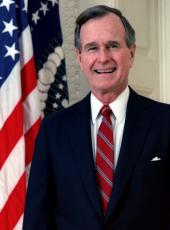The President today transmitted to Congress his report on the national security strategy of the United States as required by the 1986 amendment to the National Security Act. The 32-page report reflects the recent dramatic changes in the international environment and outlines U.S. policies to both shape and respond to these changes. It observes that we have reached a moment of historic opportunity, one created by the success of our postwar strategy. Highlights of the report include:
A policy that moves beyond containment and supports the integration of the Soviet Union into the international system.
The goal of a new Europe, whole and free, as Eastern European States rejoin the European cultural and political tradition that is their heritage.
A commitment to a strengthened European pillar in an Atlantic alliance that remains rooted in shared values and that will continue to sustain the overall structure of stability in Europe.
Support for German unification coming about through peaceful means, on the basis of democracy, and in the framework of Western relationships that have nurtured freedom for four decades, including full German membership in NATO.
Continued commitment to advance the march of democracy and freedom in the Western Hemisphere.
Recognition of the continuing importance of East Asia and the Pacific, the vital role our security ties play there, and the need to sustain a dialog with China.
Renewed commitment to an arms control agenda broader than ever before with a goal of agreements this year in START, CFE, chemical weapons, and Open Skies.
Recognition that our economic well-being is the foundation of America's long-term strength and that, in a new era, we must assess which risks can be ameliorated by means other than military capabilities -- means like negotiations, burdensharing, economic and security assistance, economic leverage, and political leadership.
A commitment to adapting U.S. military power to a strategy that looks beyond containment and provides us capabilities appropriate to new opportunities and challenges.
A movement to a smaller military, one more global in its orientation, responsive to changes in warning time, and well-suited to the demands of likely contingencies. This includes improved capabilities for the unique requirements posed by potential Third World battlefields, themselves growing in complexity and lethality.
Changing patterns of U.S. forward deployments as adjustments are made based on new perceptions of the threat, the improved reach of our forces, and the growing capabilities of our allies.
Burdensharing marked by growing national specialization in defense activities. For the United States this would include nuclear and space forces, advanced technologies, strategic mobility, a worldwide presence, power projection, and a secure mobilization base.
Identification of drug interdiction as a high-priority national security requirement.
A restatement that deterrence of nuclear attack remains the cornerstone of U.S. strategy and meeting the requirements of strategic deterrence will remain our first priority.
The report outlines the historical roots of U.S. security strategy: our fundamental values as a people, our tradition of joining in common cause with those who share our values, our commitment to an open international economic system, and the strategic demands placed on us by geography.
The report also points out that America's basic goals are enduring:
d
The survival of the United States as a free and independent nation, with its fundamental values intact and its institutions secure.
d
A healthy and growing U.S. economy to ensure opportunity for individual prosperity and a resource base for national endeavors at home and abroad.
d
A stable and secure world, fostering political freedom, human rights, and democratic institutions.
d
Healthy, cooperative, and politically vigorous relations with allies and friendly nations.
The report explains that the fundamental challenge is to relate the means available to these enduring goals in a world marked by change that is breathtaking in its character, scope, and pace. It is clearly a time of great hope accompanied by the recognition that the future world will not automatically be a safer one for American interests or values. Elements of change that deserve special attention are:
d
The democratic restructuring of Eastern Europe and the potential that exists for instability as these states enter uncharted territory.
d
A shifting balance of global economic power and the danger that trade disputes could strain political and security ties.
d
The proliferation of advanced weaponry, especially weapons of mass destruction and associated delivery systems, to Third World states.
d
The growth of threats like illicit drug trafficking, subversion, and terrorism, which are often fed by poverty, injustice, and ethnic or religious strife.
The report also emphasizes that even with great change there will be substantial continuity. The United States will remain fully engaged in the larger world and will continue to pursue its objectives in concert with those who share its values and concerns. Our approach to security will continue to be shaped by the fact that we are a nation separated by large oceans from many of our most important friends and interests. As a global power the United States will continue to bear primary responsibility for deterring global war and will defend the interests it has in common with its allies as far forward as possible. And this will still require the presence of American forces overseas backed up by an ability to project power from the United States.
The strategy report concludes with a call for close cooperation and consultation with Congress to help construct a security structure appropriate to today's opportunities and challenges.
George Bush, White House Fact Sheet on the National Security Strategy Report Online by Gerhard Peters and John T. Woolley, The American Presidency Project https://www.presidency.ucsb.edu/node/264830

